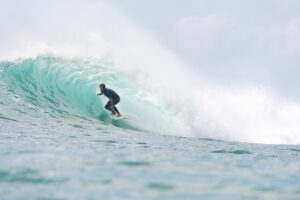Mastering Surfing: How to Get to ‘The Outside’
Surfing is an exciting sport that attracts many people. However, before you can start catching waves, you need to get to ‘the outside.’ This can be a daunting task, especially for beginners. In this article, we will discuss how to improve your paddling skills and navigate your way to the outside.
Start with a Big Board
Don’t be fooled by what you see in surfing videos. Duck-diving, which is diving under an incoming wave, is challenging and requires practice. Shortboards, which are the boards used in those videos, are not ideal for beginners. At Lanzasurf Surf School, we never start anyone on a shortboard. Instead, we recommend using a big board, usually anything over seven feet. With a big board, you can paddle out without worrying about duck-diving or sinking under the wave.
Develop Strong Paddling Skills
Paddling is 90% of surfing, and having strong paddling skills is crucial. Without them, you will have difficulty getting to the outside, and some days, you won’t make it at all. The first thing to remember is to keep open space around you, especially in front and behind. Then, focus on developing good, fast paddling skills. For small waves, paddle hard and straight into the whitewater, and do a pushup as the wave hits. This will allow the wave to pass under you instead of smacking you in the face.
For larger waves, use the big board’s advantage, which is its great paddling speed. Race to the ‘green side’ (outside) of the waves before they break. It’s essential to move out when you see other surfers moving out. Don’t stop to rest in the ‘impact zone,’ as it’s dangerous.
Ways to Deal with Large Whitewater Waves
When you’re caught inside with larger whitewater waves, you have several choices. The most common method is the kick-over. As the wave approaches, sit near the tail of the board, lifting the nose. Just before the whitewater touches your board, scissor-kick both legs in the water, pushing the board forward, and throw your weight over the wave.
Another method is the tombstone, where you turn your back to the wave and sink the board’s tail with your foot while grabbing the rails. This prevents you from getting pushed closer to shore. If the water is less than chest-deep on a sandy bottom, you may jump off, stand on the bottom, and throw your board over the whitewater, quickly ducking under the wave.
Ditch and dive is also an option, but it’s dangerous if anyone is behind you. It’s better to keep your board in hand in smaller waves. Finally, the turtle roll (flipping the board over on top of you and hanging on for life) is rarely useful, and it takes time to recover.
Conclusion
To conclude, surfing is a fun sport, but it requires practice and patience. Starting with a big board and developing strong paddling skills is essential to get to the outside. When dealing with larger whitewater waves, you have several options, and it’s important to know when to use them. Keep in mind that safety is a priority, and always be aware of your surroundings. With these tips, you’ll be surfing the waves in no time.





